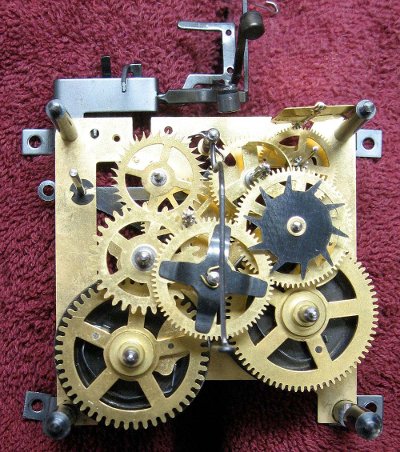
(Courtesy of Bill's Clockworks)
by John P. Pratt
28 Feb 2017, 1 Adar2 (PHC), 1 Monkey (SR), 1 Res (UV), 1 Lord (UMa), Esther (E)
©2017 by John P. Pratt. All rights Reserved.
| 1. Perpetual Hebrew Calendar |
| 1.1 PHC Year Wheel |
| 1.2 Great Year Wheel |
| 1.3 Assembling the Gears |
| 2. Religious Chronology Update |
| 2.1 New Holy Day: Last Light |
| 2.2 Twelve Tribes |
| 2.3 Moses and Aaron |
| 2.4 Latter-days |
| 3. Conclusion |
| Notes |
The traditional Hebrew Calendar is not accurate over long periods of time, so an improved version has been sought in my work. Moreover, decades of sacred calendar research indicate that God is using such a calendar for timing important holy events, but which differs from the Hebrew Calendar. My best approximation of His true version is called the Perpetual Hebrew Calendar (PHC) in my articles,[1] but the details of its workings have not been fully understood. This article announces the recent discovery of enough of those details to allow the PHC for the first time to correctly indicate the holy days for all 200 religious events listed in my Religious Chronology. This updated and more correct version has been implemented in all of the calendar conversion programs on this website.
 |
Each of the many parts of the PHC is a witness of the Creator and that the precise orbital periods of both earth and moon were carefully designed down to seconds in order to produce a long term (7,000 year) calendar with holy days occurring correctly over that entire period. Those witnesses of the Creator were already presented in earlier articles,[3] so they will not be repeated here. Those articles summarize most of the gears making up of the "cosmic clock" of the PHC. The situation has been similar to having all of the gears from a beautifully crafted mechanical clock with a note, "Some assembly required"! That assembly was finally finished last week.
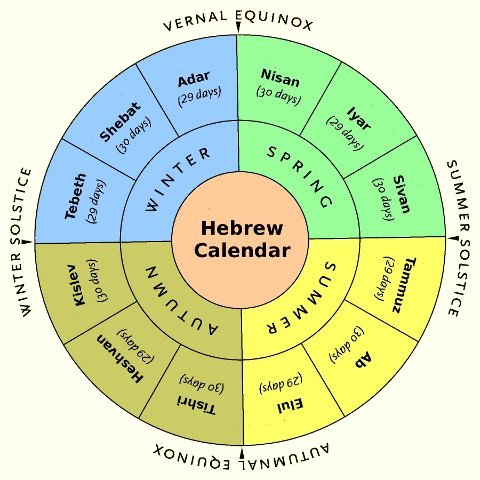 |
The traditional Hebrew Calendar (or simply "Hebrew Calendar") uses what is called the Metonic cycle to determine the length of each year. Six year lengths are needed to successfully create a series of years to do the job: 353, 354, or 355 days in years with 12 months (called "common" years) and 383, 384 or 385 days for years with 13 months (called "leap" years). A sequence of 11 such years returns one to about 2 days later in the true solar year and a series of 8 returns one to two days earlier. Combining them into one series of 19 years called the Metonic Cycle comes so close to the true length of a solar year that it is only off by about one day in 200 years. The Metonic cycle always contains 12 common years and 7 leap years. Many have noted that both 12 and 7 are sacred numbers. It is used forever in the Hebrew Calendar.
While such a cycle suggests that a wheel with 19-years on it could be used repeatedly to calculate the Hebrew Calendar, that doesn't work because the day of the week changes with each 19-year cycle. The solution used in the Hebrew Calendar is to actually calculate the position of the moon with great accuracy for one day near mid-year and use that result to determine the exact beginning day of each year. After that, the lengths of months in each of the possible year lengths is fixed.
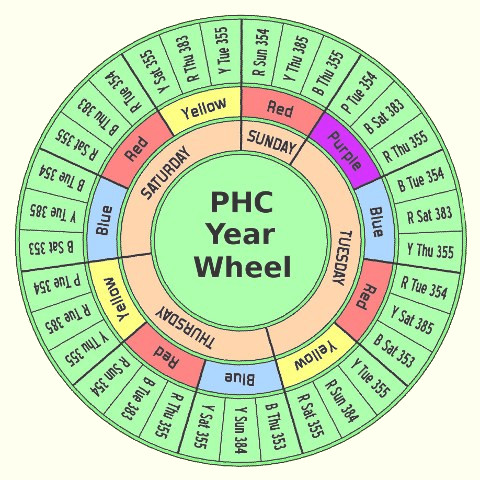 |
After three years the Hebrew calendar usually repeats to within four days on the true solar year.[6] In 1990 it was discovered that a table of sets of three Hebrew years (each called a "triad") could be used to calculate Metonic cycles. Each triad had one leap year between two common years. In 1994 it was discovered that if the table contained 11 triads, then it ended back almost exactly at the starting point. That meant that it could be used as a wheel with the first triad following the last, so it could be used perpetually. Thus the Perpetual Hebrew Calendar Year Wheel was discovered with the calendar named accordingly. It has 33 years divided into 11 sets of triads (See Figure 2). One begins on any of the triads and count a sequence 11 years. At that point, instead of using the next year, one jumps to the triad beginning with that same color year and weekday. For example, starting with the first year at the top (a Red Sunday 354, meaning it must begin on a Sunday and have 354 days) one counts 11 years. What would have been the twelfth is a Blue Saturday 353 year. Instead of continuing to use that year, jump to the triad beginning on a Blue Saturday, which is easily found at about the 9 o'clock position by looking at the first entry in the blue colored division of the Saturday area. From that point one continues with another sequence of 8 years for a total of 19 years, which forms one Metonic cycle containing 12 common years and 7 leap years. After that, jump again to the indicated triad (a Yellow Tuesday 355) to begin the next Metonic Cycle.
The wheel is so accurate that the process can be continued for about 90 years before getting about one triad off. At that point one can just jump clockwise to the next triad and continue for about another 90 years. That much has been known since its discovery over twenty years ago. Until now, the big question about the wheel has been to find the exact pattern which God uses to make those jumps.
 |
Moreover, a "month" of 30 years is defined in my work, similar to a month of 30 days, after which the Hebrew calendar approximately repeats. It is formed of a 19-year Metonic cycle followed by another 11-year sequence from the PHC Year Wheel for 30 years total. That 30-year grouping was named a Great Metonic Month in an earlier article.
Even more astounding is that there is a set of 353 years, similar to 353 days, which forms a Great Metonic Year (GMY) in which the Hebrew calendar repeats much better that in continuous Metonic Cycles. It is the kind of correction the Hebrew Calendar needs. It is a set of 18 Metonic cycles which has an accumulated error of about two days, followed by an 11-day cycle which brings the total error back to very near zero (18x19+11=353). One can even make a leap GMY by adding an extra 30-year month for a total of 383 years, even as the Hebrew calendar has a year of 383 days. Hopefully the reader is beginning to see the design of a Creator in all of this!
In the case of the Hebrew Calendar, in order to fit every year to the days of the week, a total of six different year lengths are needed. In order to fit the years correcting into the week of seven years, a total of six different year lengths are also required.
Most amazing of all, there is a very long unit that can be made of 12 GMYs of 353 years plus 4 GMYs of 383 years plus 3 GMYs of 380 years in a nearly identical pattern to the Metonic Cycle. It is called a Great Metonic Cycle in my work: 12*353 + 4*383 + 3*380 = 6,908 years (2,523,094 days). That period is close to the 7,000 needed to cover all of history. The average length of the lunar cycle in that period is 29.5305946 days which is extremely close to the best modern estimate of 29.5305956 days. The value used for calculating the Hebrew calendar is 29.5305941 days which is so good that it's been proposed in my earlier papers that the Hebrew value must have been given by revelation because no one could have measured it so accurately back then.
Because the Great Metonic Cycle is not an exact number of weeks of years, even as the Metonic cycle is not an exact number of weeks of days, another year wheel is needed. It is also made up of six types of GMYs: 350, 353, 356, 359, 380 and 383 years. They can be placed in the GMY Year Wheel shown in Figure 3. This illustration was also in my 2007 article on the subject, but it was not at all clear how to use it. Now it has been discovered that it is used the same as the PHC Year Wheel: Starting on a triad, count 11 GMYs followed by jumping to the next series of 8 for a total of the entire cycle of 19 GMYs. It is so well organized that the second sequence of 8 starts over at the same place as the first 11 did. That sequence of 8 ends such that the next 11 begins one triad before the first 11. That pattern can be followed indefinitely, but just one set of 19 suffices nearly all of history.
So far this has been a review of what has been known since 2007. There have been several problems to solve in order to assemble those gears into a working cosmic clock. Now answers to most of those enigmas have been discovered. Repeated Warning: Those not interested in these nitty-gritty details of the inner clock workings can skip this section with no loss of understanding the results.
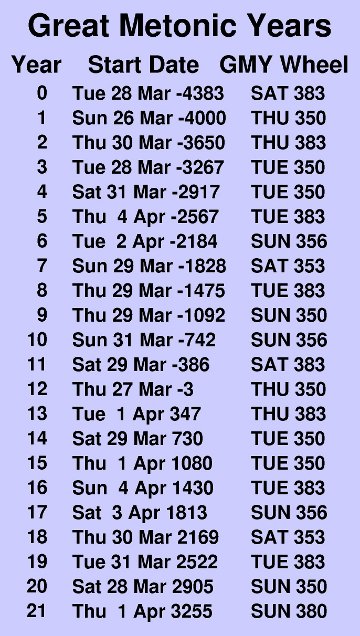 |
The Great Metonic Year Wheel has six slots which begin THURSDAY years, two of which begin triads. All of them were extensively researched until it was shown that the only one which could work to produce an elegant calendar that fit all known historical anchor dates was the triad beginning with "THU 350" (near the "2 o'clock" position in Figure 3). The THU means the year was a THURSDAY year and the 350 means that the GMY was 350 years long.
Using the GMY Wheel. It has not been known exactly how to use the GMY Wheel, but there has been one clue: the Meridian of Time. The time of the birth of Christ divided history into two parts. That point of division is somewhat past the midpoint of history and varies slightly according to what calendar is used. On the Jubilee Calendar in which history is divided into seven parts (millennia), the point comes 4/7 of the way through (57%), which begins the jubilee year 0 AD (1 BC), the very year of Christ's birth. On the Enoch Calendar which divides history into twenty Great Years of 364 Enoch years each, it comes exactly at 11/20 of the way (55%), also at 0 AD. From the discovery of the Great Metonic Cycle having 19 parts, it has seemed likely that the Meridian of Time probably occurs 11/19 of the way through (58%), especially since both the regular and great versions of the Metonic Cycle naturally divide into 11 parts followed by 8 more. Sure enough, that is how it turned out. Counting 11 Great Years on the GMY Wheel starting from Sun 26 Mar -4000 at the THU 350 position brings one to -3 AD (4 BC), just three years before the birth of Christ. It was startling to discover how close that point was to His birth. All of the sacred calendars known in my work are centered on Christ! Table 1 shows the beginning dates of all GMYs in history, calculated by jumping to the former and following sequences on the GMY Year Wheel as discussed above. Also listed are each weekday name of the beginning year of the GMY (such as THU) and also its length in years (such as 350).
PHC Year Wheel Counting. While counting 11 years followed by 8 years works on the PHC Year Wheel to create a Metonic Cycle, there are many other options. One way to construct a 353-year is to simply count out 19 Metonic Cycles but skipping the final 8-year segment. That would be nearly identical to the Hebrew Calendar which simply counts forever by Metonic cycles. That was indeed my first thought, but it was clearly not how God thinks! God loves variety!
According to Hebrew sources, the goal of regulating the Hebrew calendar was that the day of Passover on the 15th day of the first month should never fall before the spring equinox (20 or 21 March Gregorian). That is another way of saying that the first day of the year should be as near as possible to the equinox. That means that the first day would never be before 6 Mar and not after 6 Apr. That minimum range could be achieved by counting straight sequences of Metonic Cycles on the PHY Year Wheel (except for the slow drift later in the year if not corrected by a GMY). That would be simple and consistent, but also boring!
 |
How can that wide range be accomplished and what are the rules governing it? It turns out a 19-year Metonic Cycle can be divided up in several ways on the PHC Year Wheel, provided that it consists of two sequences of years each of which starts on a triad. That division ensures that it will contain 12 common years and 7 leaps years. The example given so far is to use 11 years (lowers two days in solar year) followed by 8 years (raises back 2 days). Another possibility is to count 5 years (raises 6 days) followed by 14 years (lowers 6 days) which brings one to exactly the same place but extends the range of start dates by 4 extra days, such as having a high start date of 10 Apr rather than 6 Apr. One could also count 2 days (raise 9 days) and then 17 days (lower 9 days) to maximize the range of one Metonic Cycle. Such divisions of a Metonic cycle could provide the required spread. But now it is necessary to discover the rules which govern the wide variety that God apparently loves in His creations within the bounds He sets. In this case, the question arises whether the bounds are that the variation must be kept to be within one Metonic Cycle as in the examples just given.
The exact details of this variation are still not fully understood. A set of rules has been constructed which allows the entire calendar to be calculated just from being given the starting date, so the same rules apply throughout all 7,000 years. Some of them, however, could still be adjusted slightly with the discovery of new known anchor dates. This is one source of the mere 90% accuracy claimed at the beginning of this article.
PHC Year Wheel advances. The precise use of the PHC Year Wheel has not been known. It was discovered by showing that one use is to count 11 years, then jump to a new triad starting slot that matches what would have been next year, and then counting 8 more years to complete one Metonic Cycle. That process can be repeated for almost 90 years and still accurately represent the coming of the new moon to start the next year. After that time, it is necessary to advance one triad, which often does not even change the starting day. For example, looking at Figure 1, if the next Metonic Cycle would have begun on a Blue Tuesday (about 2 o'clock on the wheel) then it would jump to begin the next triad three slots later on a Red Tuesday. Thus the year would still begin on a Tuesday even though the triad was advanced. Those colors indicate the precise position of the moon as to how visible it should be on the first day of the year. Only recently in the last few months was it discovered that advancing the starting triad four times in common Great Metonic Years and five times in leap Great Metonic Years yields perfect accuracy over a sequence of 19 GMYs. The last triad advance is then skipped in the last GMY of the sequence.
Great Metonic Year Colors. The triads on the PHC Year Wheel are colored according to exact age (visibility) of the new moon on the beginning date. In my current model each Great Metonic Year also has a similar color. They are not shown in Figure 3 because the color depends upon just what year is chosen as the beginning year. Those colors are used to determine just when the triad advances are done.
Year Template. Once the year length is determined for any given year, the Hebrew Calendar has a fixed set of month lengths for each year. In common years all of the variation in month lengths occurs in the eighth and ninth months, having either 29 or 30 days. The other ten months always have the same fixed lengths, alternating months of 30 and 29 days, averaging 29.5 days, very close to the 29.53-day lunar cycle length. In leap years, an extra month called Adar 1 of 30 days is inserted before the last month of 29 days with the last month being renamed from Adar to Adar 2 (or Ve Adar).
For my purposes, it was important to know if God is actually using those Hebrew Calendar month lengths for the PHC or if they were simply man-made. It could not be assumed that any part of the Hebrew Calendar was correct without testing it. The result has been that the traditional Hebrew month lengths work in every case, so there was no need to change them.
 |
Could a similar arrangement be used to divide a Great Metonic Year into Great Metonic Months? It turns out that a simple regrouping of a series of Metonic Cycles can accomplish exactly that! Figure 4 shows how a straight series of 11-year and 8-year sequences from the GMY Year Wheel can be thought of in two entirely different ways. On the one hand, it is simply a series of Metonic cycles. But on the other hand, if considered to be groups of three sequences, then it can be thought of as an alternating series of Great Metonic Months of 30 and 27 years. This has been one of the hidden secrets behind the Great Metonic Year! At its heart is not a series of Metonic Cycles, but instead each GMY has a fixed pattern of Great Metonic months! The answer to the question posed above about the bounds set to the variation allowed in sequence lengths is not that they are limited to one Metonic Cycle but rather to one Metonic Month.
For example, a Great Metonic Year of 353 years can be formed of 9 Great Months of 30 years, 1 of 29 years (with four sequences), and 2 of 27 years. The other required Great Metonic Year lengths can all be achieved by switching years of 27 for 30 in common GMYs and adding an extra 30 in leap GMYs. That is extremely compelling both because it follows the same pattern as the usual Hebrew year and also because it works! It is astounding to me that this division into Great Months was only discovered this month when it now seems like it should have been one of the first options explored. It has been a hidden secret until this time.
In the current PHC model the arrangement and length of Great Months is the same in every Great Year of a given length. That is the rule for the Hebrew Calendar and it also works for the PHC. Thus, God's house is a house of order. There are some rules which are always followed and others which allow the vast variation that we see throughout His creations. Unbridled variation is not allowed, but rather every law always applies only within certain bounds (D&C 88:38). In this case the variation discussed in traversing the PHC Year Wheel is not confined to Metonic cycles as were used in the examples given above about using the PHC Year Wheel. In fact, the Metonic Cycle as such is not even explicitly used anywhere in the PHC. The bounds to the variations in counting around the wheel are established by the length of each Great Metonic Month. Thus, once a Great Metonic Year length is known, the arrangement of Great Month PHC Year Wheel sequence lengths for that GMY are then all locked in. Finally, once the pattern of sequences is determined for any given month, then it must stay that way throughout history.
For example, in the current model every Great Metonic Year of any length always has 30 years in its first month of years. That is the same as the Hebrew Calendar in which the first month always has 30 days. The PHC Year Wheel count for that month is always an 11-year sequence, followed by jumping to a 5-year sequence, and ending with a 14-year sequence for a total of 30 years. That 11-5-14 pattern gives four days more variation in the beginning date of the year in spring than a straight Metonic 11-8-11 year count. That choice of counts was made because it fits the historical dates. That same pattern is used for the first month of all 21 Great Metonic Years in history. The compelling evidence that it is correct is that the same pattern always works. After more than a decade working on this, it is clear that almost any little mistake breaks the calendar. That is why the rules seem certain enough to publish now.
That summarizes the principal elements of the PHC as currently understood. It is believed that all of the rules presented here are finally known and accurate. Those not explicitly explained are still subject to minor corrections.
In the process of checking all 200 published proposed dates of historical religious events, it became clear that about half of them are truly anchor dates which were locked in by the witness of several other sacred calendars. The most important of those is the Sacred Round which is a perpetual day count of 260 days which never has any extra leap days inserted. Like the week, it is a fixed grid to which proposed dates can be anchored.
Thus, it was expected that some dates in my proposed Religious Chronology would be modified when the true PHC was discovered. Indeed, such has been the case but only for a very few dates. Some formerly proposed dates turn out to be impossible on the PHC and others which were formerly not considered viable are now allowed as candidates.
Let us now discuss those dates which have changed due to the recent advances in the PHC.
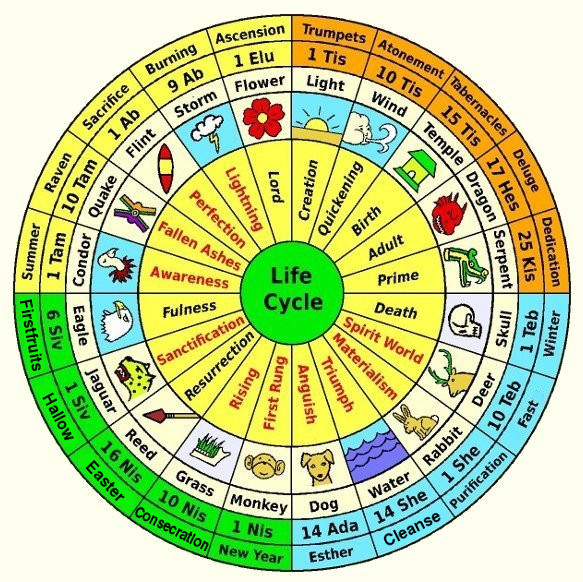 |
Using the new PHC calendar that day turns out to be 2 Tebeth, not 1 Tebeth. So did that cause the new PHC model to be rejected? When the discrepancy was pondered, it turned out it still fits perfectly! The day 25 Kislev one week earlier in the preceding month is the beginning of the 8-day Festival of Lights (Hanukkah). Depending on the year, the last day of that holy week usually falls on 2 Tebeth. In traditional Judaism, none of the days of Hanukkah are major holy days on which no work is to be done. It is just a festival during which a candle is lit on each of the days.
 |
The name of that last day of the Festival of Lights can be called "Last Light", when the last candle is lit. The deeper symbolism could be that it represents the second death after which one's light goes out. If so, 1 Tebeth represents physical death and 2 Tebeth is spiritual death. The last day of the Festival of Lights can occur on either 2 or 3 Tebeth, depending on the year length. The current understanding of the PHC is that Last Light is only a holy day when it falls on 2 Tebeth. Thus, Enos was born on the holy day Last Light, consistent with all of the other death symbols.
One date which changed concerning Jacob and his sons who became fathers of the twelve tribes of Israel was the date of his wedding to Rachel. Before it was listed as 1 Iyar, but now that has been changed on the PHC Calendar to be the holy day 1 Nisan, the first day of the year. The date of his marriage to Leah a week earlier is also changed, but it was not on a holy day.
The births of twelve of the children of Jacob (Israel) occurred in the seven years after his marriages to Leah and Rachel. Those birth dates all fall in one sequence on the PHC Year Wheel. Only one of the proposed dates of the thirteen children of Jacob (don't forget Dinah!) has to be adjusted according to the new PHC. It is the birth date of Gad, which had been one of the least certain.[9]
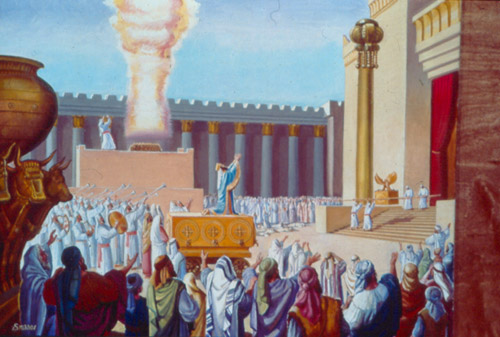 |
There is another witness that the date is not only correct but may have deep meaning. The Festival of Lights is also known as the Feast of Dedication (Hanukkah) because it celebrates when the one-day supply of oil for the eternal flame kept burning for 8 days at the rededication of the Temple of Solomon on Mon 21 Nov -164 (165 BC) which fell on 25 Kislev. That date is not one proposed by me, but is a well established date from history. It turns out that day was also both the day 1 Temple on the Sacred Round and also a rare holy day on the Mars Calendar. The date proposed for Gad's birth is also both of those! Of course, 1 Temple is an ideal date for the temple to be born again, with the double symbolism of being a temple and also being born! The fact that the Mars Calendar is involved is an added witness that something important is going on. The name Gad is linguistically similar to the English "Goth", so the question arises whether the Goths, for whom Gothic cathedrals (temples?) are named, might be from that tribe.
 |
His brother Aaron, namesake of the Aaronic Priesthood, did not have a very illustrious birth date before, but it was the best available and seemed worth publishing. It fell on 1 Kislev which was a date which had no apparent connection with the Priesthood, his principal calling.
On the new version of the PHC, his birth date is allowed to fall on Wed 12 Jan -1544 (1545 BC) which was the day 1 Shebat. That holy day begins the priestly month of Shebat. Levi, father of the priestly tribe, was born on 14 Shebat and died on 1 Shebat! Thus, Levi's vital dates tie to both of these illustrious great grandsons of his!
Another date which changed was that of Moses going before Pharaoh. Before it was listed as being 1 Tebeth, but with the new PHC it is a month later on 1 Shebat, a priestly holy day.
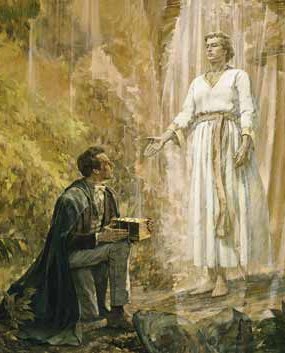 |
Learns of Golden Plates. Joseph Smith's prayer on the evening of Sun 21 Sep 1823 and the appearance the angel telling him of the golden plates throughout the night and finally actually finding the place the plates were buried all occurred on the same Hebrew day because it started in the evening. That day was 17 Tishri on both the Hebrew Calendar and also on my former version of the PHC which is not a holy day. On the new PHC, that date falls on 15 Tishri, the Feast of Tabernacles, which is a bigger feast even than Passover in the spring.
1829. All of the dates (after March) in 1829 now differ from the former PHC and the Hebrew Calendar by an entire month and also a day or two. The first day of the year was later than usual, on Mon 7 April, which seems to have the significance of being a more holy year as mentioned earlier. That was the very day on which Oliver Cowdery began to act as scribe for the Prophet Joseph Smith. It has already been noted that that same day was doubly sacred on the Enoch Calendar, being both the holy day and the year of Consecration. It was also holy on 5 other sacred calendars, including being 13 Temple on the Sacred Round, the day of the resurrection of Jesus Christ.
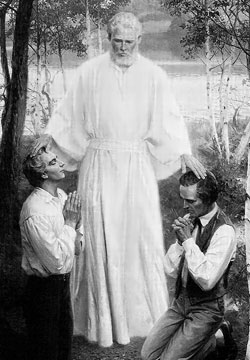 |
1831. The other year which is significantly changed is 1831. It starts extremely late in that 30-year Great Metonic Month: on Thu 14 Apr 1831. It does not change any holy days listed on my Religious Chronology but the importance seems profound because of the following pattern involving John the Baptist. The year AD 29 began on 3 Apr and the year AD 1829 began on 7 Apr (both late in the spring). In AD 29 John baptized Jesus and in 1829 he appeared and authorized Joseph and Oliver to baptize each other. The year AD 31 began on 10 Apr and in 1831 it began on 14 Apr (both at the extreme limits for the GMY). The year AD 31 was the year of John's execution. The year 1831 also in a way represented a high point in the restoration of the Church. It was the year that the first high priests were ordained and also when the saints attempted to found the city of Zion to live the law of consecration. After that failed, the Church was given lower laws to live, such as the law of tithing. Thus, the four high spiritual events all occurred in PHC years which commenced late in the spring. Surely much more remains to be discovered in this area.
All other restoration holy dates listed remain intact, except that the Nauvoo temple no longer had it cornerstone laid on Passover, but two days previous.
Many new details of the workings of the Perpetual Hebrew Calendar, which God seems to be using, have been recently discovered and implemented into the PHC calculator programs on this website. Each facet of the details is a witness of the amazingly precise crafting by the Creator of the earth's and moon's orbits to create a precision timepiece that runs accurately throughout history. All of the features of the traditional Hebrew year remain intact, but the intercalation is done according to the Lord's day-year pattern, rather than counting straight Metonic Cycles. That pattern is based on years being counted in the same manner as days, such as 30-year Great Metonic Months similar to 30-day lunar months, and 353-year common and 383-year leap Great Metonic Years similar to the 353-day and 383-day years of the Hebrew Calendar. Rules for use of the PHC Year Wheel and the GMY Wheel are discussed as well as other details required to understand the PHC. Truly it is a crown jewel among calendars and a powerful, compelling witness of the handiwork of the Creator!